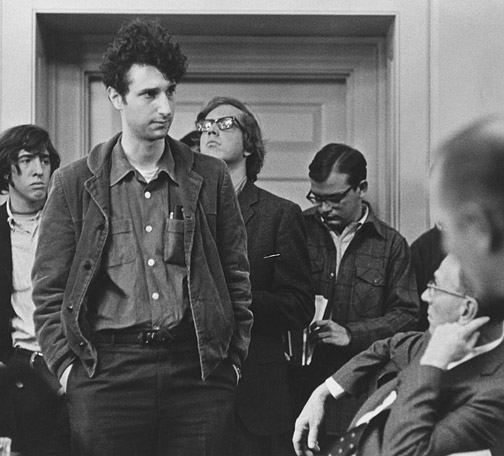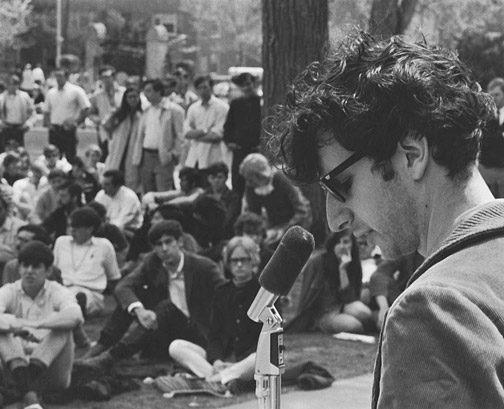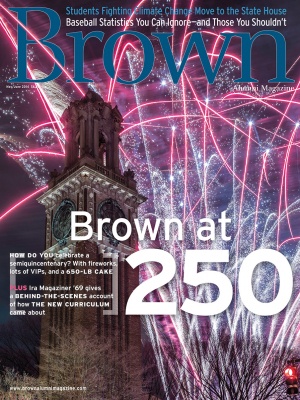In 1965, when I became a Brown freshman, black Americans in Southern states could not eat at white lunch counters. They had to ride in the backs of buses and use separate bathrooms. Black Americans in northern states could not move into middle-class neighborhoods and were paid less than their white coworkers for the same jobs. Women made up only two percent of the student bodies at medical and law schools. A woman was raped and beaten in Central Park in New York City, and news accounts led with the commentary that “she was asking for it because she was wearing a short skirt.”

While America provided unparalleled freedom and opportunity for many people, there were problems that needed to be addressed.
At most American universities, education consisted of fact-filled lectures followed by rote regurgitation of those facts on tests that left little room for creative thinking. Students were passive learners moving from one required course to another. Knowledge was divided into separate compartments, and students had little responsibility for their own education.
There were only a handful of African American students at leading U.S. universities, and they represented fewer than two percent of the students at Brown. Women made up only twenty percent of the combined men’s college and Pembroke College student body. Students had no say in University governance. Men could not be in a woman’s dorm room unless the door was open, and visiting hours were limited.
But in the space of six years all this would change—both nationally and at Brown—and students played a significant role in bringing about those changes.
The student idealism of the late 1960s has been caricatured for its
extremes—the “yippies” and the “hippies” and the “sex, drugs, and rock
and roll.” (I will not comment on the sex and drugs, but the rock and
roll was and remains something special.) But there was a lot more to
student life than this. The movements that students helped initiate and
support transformed America in positive ways. America, and Brown
University, would never be the same.
Two events at Brown stand out: the commitment to affirmative action
forged when black students walked out of the University in protest in
1968, and the adoption of the New Curriculum in 1969. In both cases,
students conceived of the changes that were needed and organized
political movements that forced those transformations. They were aided
by a University administration that was willing to listen and engage
and that had the courage to change.
My first attempt at student activism at Brown was born of necessity and self-interest. At that time, students were required to eat at the Ratty. The food was awful, and so I usually bought my dinner from a truck called Pizza Pete that parked near my dorm. Pete eventually became the official caterer of the education movement at Brown.
One of my main projects as freshman class president was to organize a petition and hold rallies to eliminate the requirement to eat at the Ratty. Needless to say, it was a popular cause. I got the Brown student government to endorse the movement. We thought we were making progress when another student and I were invited to meet then-president Barnaby Keeney. We showed up at University Hall ready to negotiate. His secretary ushered us into his office. He was sitting at his desk, which seemed to be elevated a good five feet off the floor. He never acknowledged us. Instead, he began dictating into a microphone. His dictation was a letter expelling us from Brown. We sat in amazement. When he finished, he turned to us as if surprised to see us and then said his only words: “You can go now.” His secretary, who had been waiting in the back of the office, escorted us out.
We decided we had nothing to lose, so we kept agitating, fully expecting the campus police to serve us with an eviction notice. But they never came. We did not win that battle that year, but eventually the mandatory contracts were ended, and the food got better.
In the spring of my sophomore year, my peers and I became frustrated by the education we were receiving at Brown, and so we decided to act. Already accustomed to joining civil rights marches and demonstrations against the Vietnam War and against environmental pollution, we felt that we could have the greatest impact by reforming our own institution. We could help establish an education system at Brown that would encourage more creative and responsible leadership, and we could try to address racial and sexual injustices within our own community.
In the summer after my sophomore year, I drafted a 400-page report that was then edited, in the fall, by a group of twenty students led by Elliot Maxwell ’68. The report made recommendations on how to improve Brown’s education system.
There were a few fundamental principles guiding our recommendations:
• Students should be
actively responsible for their education, choosing what to study and
aided by a strong counseling system, rather than being subjected to
requirements that encouraged passive learning. Students should have the
choice to develop independent concentrations with a faculty adviser
rather than having to fit a predetermined concentration design.
• The teaching of facts
was less important than teaching students how different disciplines
approached knowledge and learning. If a student knew how to learn, then
he or she could engage in a lifetime of learning, including acquiring
factual knowledge.
• Instead of large
lecture courses in early years and then seminars in later years,
students could benefit more from small classes in their early years and
then more independent and group-independent work in their later years.
• Interdisciplinary
activities should be encouraged, going beyond the traditional
compartmentalization of knowledge in departments.
• Letter or number
grades were not particularly valuable methods of evaluation. Written
performance evaluations that actually helped students understand in
some detail how they could improve were more meaningful.
• Encouraging students
to be more responsible for their learning—removing the props of
requirements, letter grades, and spoon-fed course selections—would
encourage better, more creative learning and a more meaningful form of
rigor.
This philosophy of education was designed to produce leaders who would
be entrepreneurs, who would question authority and have the skills to
create new paradigms in government, business, and science.
The substance of our proposed reforms was important, but the grassroots process that we implemented was also crucial to the success and sustainability of those reforms. We had looked at other schools where small groups of students engaged in violent demonstrations or occupied buildings while the majority of students merely observed from across the street. We didn’t think this was the best way to bring long-lasting change. Instead, we set out to mobilize the whole student body. If we had large numbers, we could achieve greater results with moderate tactics. In September 1968, I pulled together a group of twenty students to mobilize the student body and to lobby faculty. Our aim was to get the faculty to pass fundamental reforms by the end of the school year.
What made us think we could pull this off? In part, our confidence came from the successful Spring Weekend I had spearheaded the year before. In my sophomore year I had decided to organize concerts on campus on a scale that had never been attempted before. We brought in the Lovin’ Spoonful, the Doors, Mitch Ryder and the Detroit Wheels, and the Paul Butterfield Blues Band. Thousands of students attended the concerts. This culminated—in my junior year—in the first large-scale Spring Weekend ever attempted in New England.
We had James Brown, Dionne Warwick, Procol Harum, the Yardbirds, and Dizzy Gillespie; for the poetry crowd we had Allen Ginsberg and Lawrence Ferlinghetti. We had classical pianist Lorin Hollander, the comedian Jean Shepherd, and folk musicians Ian and Sylvia. We also set up a seventy-two-hour classic-movie marathon. Allen Ginsberg and some other performers were so impressed by the lineup that they stayed for the whole weekend.
To launch the event we chartered a small airplane to fly over the College Green and dump thousands of colored Ping-Pong balls stamped with “Welcome Spring Weekend.” The University administration was already worried about the scale of our programming, anticipating busloads of students arriving from schools as far away as Washington, D.C. When they heard about the Ping-Pong balls, they said, “Absolutely not.” They feared that a falling ball might hit someone and cause dire injury. We had some physics students prepare a treatise to show that no damage could be done, but the administration was not persuaded.
We had already colored and stamped thousands of Ping-Pong balls and could not get a refund on the chartered plane, so we told the administration that we would not yield. But in fact, after consulting with our engineering-student brain trust and learning that they, too, were envisioning potential car accidents caused by errant balls, we had decided to call it off. But we did not tell the administration. Instead, we instructed the plane to fly over the Green towing a banner saying “Welcome Spring Weekend.” When nervous members of the administration dashed onto the lawn to watch the plane, we had some students sneak in through the back of University Hall and dump the Ping-Pong balls in the dean’s office.
Looking back on it now, I’d say that this wildly successful Spring
Weekend, and the organization it took to pull it off, was a precursor
to the organized effort we created to pass the New Curriculum.
One of our first tasks in the fall of 1968 was to produce enough copies
of the report we had written. At a time when dinosaurs ruled the earth,
this was no easy challenge. We had no Internet, no copy machines, no
electric typewriters, and the only computer at Brown—the IBM
System/360—was larger than a railcar.

We started visiting dorms to talk with students. Usually on the first visit somebody on our committee had a good friend in the dorm who could gather four or five people together, so we could talk to them about the report. We were then able to motivate them to recruit more of their friends for another meeting a few days later. We kept returning until we had twenty or thirty students showing up to a meeting in a dorm. In all cases, the meetings included detailed discussions so that students truly understood the report and came to support it.
At the same time, we sent the report to all faculty members and asked for appointments to discuss it with them. We sent teams of three students, one of whom already knew the professor, to meet each faculty member. Often when we showed up faculty members had not read the report or had only skimmed it. So we actively engaged them in a dialogue, often leaving them a bit shaken. We then rated the faculty members on a scale of one to four, just as one would in a political campaign. The ones were definite supporters and the fours were a lost cause. We posted people outside faculty meetings to take attendance, which helped us target our efforts on the “likely voters” who were twos and threes.
In November, we started holding short rallies on the Green. They were limited to thirty minutes. Student speakers were told to limit their talks to five minutes each, to be humorous and entertaining, but also to illustrate some problem with the curriculum as it existed. The number of attendees at our rallies grew over time, until more than a thousand students were regularly attending.
We also visited student clubs and other places where students congregated, and we gradually built lists of interested students, creating a large network so that eventually, if we needed to do so, we could turn out thousands of students on short notice.
We pushed for the creation of a high-level committee of administration, faculty, and students to consider the recommendations, with a mandate to produce a comprehensive reform package to be considered by the full faculty before the end of the year. (Prior to this, students did not serve on University committees.)
Finally, in December 1968, when our rallies were drawing large crowds on campus, and we had a petition signed by well over half the undergraduate student body asking for the committee to be established, I sat down with President Ray Heffner for a serious talk. Other universities were experiencing violent protests and occupations of administration buildings. We had produced a four-hundred-page footnoted report and were engaging in discussion and debate worthy of a university setting. We had broad-based student support. We did not want to engage in more militant tactics. We were simply asking that the University form a committee to consider our recommendations. The president agreed. A high-level committee including some student members was formed under Vice Provost Paul Maeder. They met frequently and urgently and produced a set of recommendations broadly in line with those we had advocated.
Around this time, black students at Brown took a courageous step. They orchestrated a walkout to press for greater minority recruitment and more African American faculty and course work. We immediately utilized our network to mobilize widespread student support for their efforts through a rally and a petition that was signed by almost 3,000 Brown students.
On the first night of the walkout, I was invited to the president’s house to meet with senior administrators and trustees and discuss the situation. I told them that, if they did not negotiate a satisfactory resolution and address the issues being raised, a massive walkout of white students would take place in sympathy with our black student compatriots.
To their credit, administration leaders like President Heffner, Provost Stoltz, Vice Provost Maeder, Dean Eckelmann, and corporation student life chair Judge Alfred Joslin ’35 were enlightened leaders who understood that times were changing, and they became active partners in that process. Had they taken the hard-line approach of officials at other universities, Brown would never have undergone such a successful transformation. The black walkout yielded important concessions, and we turned our attention back to education reform.
From January to April 1969, a committee led by Paul Maeder drew up a set of recommendations for curriculum reform based on the suggestions in our student report. In May, only the three students who were on the Maeder committee were allowed to attend the final faculty meeting in Sayles Hall to vote on the recommendations. But we persuaded the administration to set up loudspeakers so that students might congregate on the Green outside and hear the proceedings. Aided by fortuitous good weather, over 80 percent of the student body gathered outside. When a faculty member in Sayles Hall endorsed the reforms, the crowd loudly cheered, while a chorus of boos accompanied any negative statement. The reforms passed overwhelmingly.
The mobilization of students allowed us to bring other needed changes.
By the time my class left in 1969, Brown was on a course to increase its African American student population dramatically and to increase admissions of other minority students. Pembroke College was to be disbanded, and women would soon make up half of all Brown students. An education system was established that put student choice and responsibility and more creative learning at the center of the educational process. Brown students were engaging in activities in the Rhode Island community to combat poverty, improve the environment, and fight for social justice. Students were also serving on University oversight committees and were allowed to run businesses through the Brown Student Agencies to serve other students. And parietal rules gave way to coed dorms.
Nationally, civil rights demonstrations—often organized by students—led to laws being implemented that would reverse centuries of racial discrimination. Student-led protests had forced the president of the United States not to seek a second term, and large parts of society were calling for an end to the Vietnam War. The number of women admitted to professional schools was increasing dramatically. The roles of women were being redefined, and attitudes toward sexual harassment were changing to blame the harasser, not the harassed. Movements like Earth Day and protests against air and water pollution would eventually lead to the Clean Water and Clean Air Acts, and the voting age was moved from twenty-one to eighteen.
Brown and America were transformed in ways that were positive and have endured. This is the legacy of the student generation of the late 1960s and early 1970s. As we now advance into old age (though I still think of myself as being twenty-one years old, even if my body tells me differently), the legacy of our student days is one in which we can take great pride.
Today’s Brown students benefit from the values that my generation fought for: civil rights, equality between the sexes, a cleaner environment, a more creative and open educational system at Brown, and the reduction of poverty. But there are important battles today’s students should fight for the next generation. Problems of global poverty, climate change, growing income inequality in America, and equal rights for gay and lesbian Americans are among the issues that rightfully command the attention of today’s Brown students. I wish today’s student activists at Brown success as they take on these and other important issues.
Ira C. Magaziner is vice chairman and CEO of the Clinton Health Access Initiative and chairman of the Clinton Clean Energy Initiative, both of which he cofounded with former president Bill Clinton. This article is from the just-published The Brown Reader: 50 Writers Remember College Hill.
Join the BAM conversation on Facebook and Twitter.




